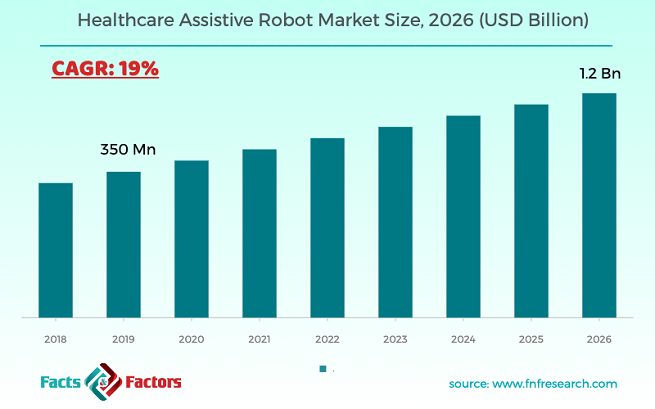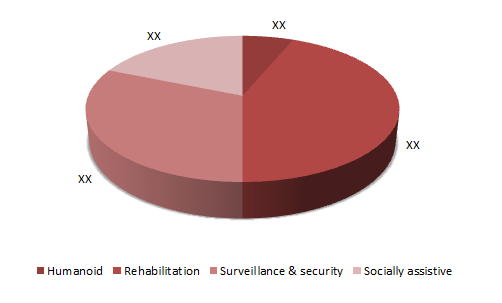Search Market Research Report
Healthcare Assistive Robot Market Size, Share Global Analysis Report, 2020–2026

Healthcare Assistive Robot Market By Product (Humanoid, Rehabilitation, Surveillance& Security, Socially Assistive), and By Application (Stroke, Orthopaedics, Cognitive & Motor Skills, Sports): Global Industry Outlook, Market Size, Business Intelligence, Consumer Preferences, Statistical Surveys, Comprehensive Analysis, Historical Developments, Current Trends, and Forecast 2020–2026
Industry Insights
[180+ Pages Report] According to the report published by Facts Factors, the global healthcare assistive robot market size was worth around USD 4.1 billion in 2019 and is predicted to grow to around USD 11.2 billion by 2026 with a compound annual growth rate (CAGR) of roughly 22% between 2020 and 2026. The report analyzes the global healthcare assistive robot market drivers, restraints/challenges, and the effect they have on the demands during the projection period. In addition, the report explores emerging opportunities in the healthcare assistive robot market.

This specialized and expertise oriented industry research report scrutinizes the technical and commercial business outlook of the healthcare assistive robot industry. The report analyzes and declares the historical and current trends analysis of the healthcare assistive robot industry and subsequently recommends the projected trends anticipated to be observed in the healthcare assistive robot market during the upcoming years.
The healthcare assistive robot market report analyzes and notifies the industry statistics at the global as well as regional and country levels in order to acquire a thorough perspective of the entire healthcare assistive robot market. The historical and past insights are provided for FY 2016 to FY 2019 whereas projected trends are delivered for FY 2020 to FY 2026. The quantitative and numerical data is represented in terms of both volume (Thousands Units) and value (USD Million) from FY 2016 – 2026.
 Key Insights from Primary Research
Key Insights from Primary Research
- According to the primary researcher operating in the global healthcare assistive robot market, the market was valued at USD 4.1 billion and is expected to be valued over USD 11.2 billion.
- The healthcare assistive robot market is predicted to witness a significant growth of nearly 22% during 2020-2026 due to the services offered robot in the healthcare sector.
- By product analysis, the rehabilitation category is expected to grow in the coming years owing to its adoption in the patient's recovery process.
- By application analysis, the orthopedics category headed the market owing to the increasing number of injuries caused by accidents globally and the adoption of orthopedics robots.
- North America dominated the global healthcare assistive robot market attributed to increased technology, investment, and awareness among people about the use of robotics.
 Key Recommendations from Analysts
Key Recommendations from Analysts
- Our analysts recommend that the surveillance and security robot segment is estimated to provide sluggish growth over the forecast period is due to the performance of these robots to monitor, and other activities.
- The Asia Pacific is expected as the fastest-growing region attributed to the increasing spending on healthcare.
- Europe is projected to boost the market attributed to the growing focus of the manufacturer towards the innovative technology in healthcare assistive robots.
- A socially supporting robot offers the benefit in animal therapy, as well as it is used to reduce patient stress, these features may produce growth opportunities in the market.
- The growing adoption of the healthcare assistive robots in developed and developing countries combined with the various beneficial features offered by the robots, the market is expected to boost in the future years.
 Market Attractiveness By Application Analysis
Market Attractiveness By Application Analysis

The quantitative data is further underlined and reinforced by comprehensive qualitative data which comprises various across-the-board market dynamics. The rationales which directly or indirectly impact the healthcare assistive robot industry are exemplified through parameters such as growth drivers, restraints, challenges, and opportunities among other impacting factors.
Throughout our research report, we have encompassed all the proven models and tools of industry analysis and extensively illustrated all the key business strategies and business models adopted in the healthcare assistive robot industry. The report provides an all-inclusive and detailed competitive landscape prevalent in the healthcare assistive robot market.
The report utilizes established industry analysis tools and models such as Porter’s Five Forces framework to analyze and recognize critical business strategies adopted by various stakeholders involved in the entire value chain of the healthcare assistive robot industry. The healthcare assistive robot market report additionally employs SWOT analysis and PESTLE analysis models for further in-depth analysis.
The report study further includes an in-depth analysis of industry players' market shares and provides an overview of leading players' market position in the healthcare assistive robot sector. Key strategic developments in the healthcare assistive robot market competitive landscape such as acquisitions & mergers, inaugurations of different products and services, partnerships & joint ventures, MoU agreements, VC & funding activities, R&D activities, and geographic expansion among other noteworthy activities by key players of the healthcare assistive robot market are appropriately highlighted in the report.
Robots simplify and make jobs more productive, produce accurate results without time-consuming. Healthcare robots are intelligent in their design, interact with patients through interactions between humans and machines and trigger their cognitive, social and emotional role. Robots have been extremely helpful in the medical industry as they are helpful in tracking the number of activities in a number of hospitals and health centers. This is achieved through the control of admitted patients in clinics and hospitals, which improves the quality of life. In recent times, robots have shown their importance in the health sector because they can monitor the activities of patients and determine their physical and emotional conditions and ultimately their purpose. In social human-robotic interactions (HRIs) with patients, healthcare is smart and helps improve residual physical, cognitive and emotional functionality.
The growing geriatric population is vulnerable to chronic conditions. According to statistics, there has been an increase in the number of elderly people in recent years. Another factor expected to increase is the increasing number of injuries caused by incidents, the increasing incidence of strokes, the increasing number of patients worldwide and the increasing number of chronic diseases that have led to the growth of the industry. In addition, several scientists are designing innovative healthcare robotics technologies to improve patient care. Robots are used for other operations, including knee surgery, joint replacement, and cardiac surgery. Factors that drive the growth of the robotic healthcare sector are increasingly needed to support and monitor post-stroke rehabilitation. The high cost of the robot can, however, hinder market growth.
The healthcare assistive robot market research report delivers an acute valuation and taxonomy of the healthcare assistive robot industry by practically splitting the market on the basis of different types, applications, and regions. Through the analysis of the historical and projected trends, all the segments and sub-segments were evaluated through the bottom-up approach, and different market sizes have been projected for FY 2020 to FY 2026.
 Report Scope
Report Scope
Report Attribute |
Details |
Market Size in 2019 |
USD 4.1 Billion |
Projected Market Size in 2026 |
USD 11.2 Billion |
CAGR Growth Rate |
22% CAGR |
Base Year |
2019 |
Forecast Years |
2020-2026 |
Key Market Players |
Barrett Technology, Ekso Bionics Holdings, Cyberdyne, GaitTronics, Hocoma, Hansen Medical, HONDA Motor Co. Ltd., and Kinova Robotics, and Others |
Key Segment |
By Product, Application, and Region |
Major Regions Covered |
North America, Europe, Asia Pacific, Latin America, and the Middle East & Africa |
Purchase Options |
Request customized purchase options to meet your research needs.Explore purchase options |
The regional segmentation of the healthcare assistive robot industry includes the complete classification of all the major continents including North America, Latin America, Europe, Asia Pacific, and Middle East & Africa. Further, country-wise data for the healthcare assistive robot industry is provided for the leading economies of the world.
The healthcare assistive robot market is segmented based on product and application. On the basis of product segmentation, the market is classified into humanoids, rehabilitation, surveillance & security, socially assistive. In terms of application segmentation, the market is bifurcated into the stroke, orthopedics, cognitive & motor skills, sports.
 Some of the leading players in the global market include
Some of the leading players in the global market include
- Ekso Bionics Holdings
- Barrett Technology
- GaitTronics
- Cyberdyne
- Hansen Medical
- Hocoma
- HONDA Motor Co. Ltd.
- Kinova Robotics
The taxonomy of the healthcare assistive robot industry by its scope and segmentation is as follows:
 By Product Segmentation Analysis
By Product Segmentation Analysis
- Humanoid,
- Rehabilitation,
- Surveillance & security,
- Socially assistive.
 By Application Segmentation Analysis
By Application Segmentation Analysis
- Stroke
- Orthopedics
- Cognitive
- Motor skills
- Sports
 By Regional Segmentation Analysis
By Regional Segmentation Analysis
- North America
- The U.S.
- Canada
- Europe
- Germany
- The UK
- France
- Spain
- Italy
- Rest of Europe
- Asia Pacific
- China
- Japan
- India
- South Korea
- Southeast Asia
- Rest of Asia Pacific
- Latin America
- Brazil
- Mexico
- Rest of Latin America
- Middle East & Africa
- GCC
- South Africa
- Rest of Middle East & Africa
Industry Major Market Players
- Ekso Bionics Holdings
- Barrett Technology
- GaitTronics
- Cyberdyne
- Hansen Medical
- Hocoma
- HONDA Motor Co. Ltd.
- Kinova Robotics

Copyright © 2024 - 2025, All Rights Reserved, Facts and Factors


